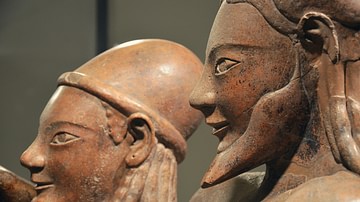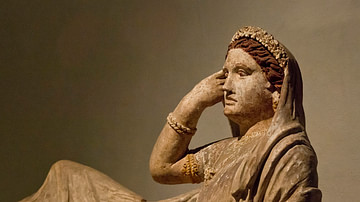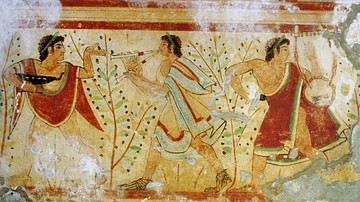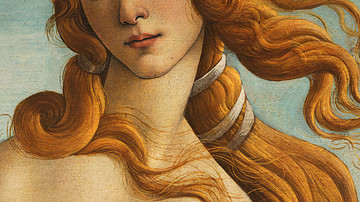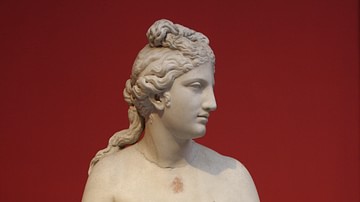The nude figure is a universal visual theme, deeply rooted in the history of art, and it is seemingly ubiquitous in the art of the ancient civilizations of the Near East and Mediterranean. The Antikenmuseum, in Basel, Switzerland, recently opened a new exhibition - Naked! The Art of Nudity - which carefully examines every facet of nude art in the ancient world, probing its meaning and legacy in Western conceptions of beauty and morality. In this exclusive interview for Ancient History Encyclopedia, James Blake Wiener speaks to Dr. Tomas Lochman, curator of the exhibition at the Antikenmuseum, about how ancient peoples in the Mediterranean and Near East viewed nudity.
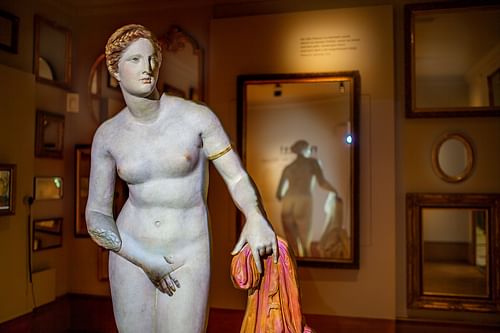
JBW: With the ongoing debates surrounding feminism, gender studies, and, more recently the #MeToo movement, many people are raising questions about the artistic representation of naked bodies in our museums. Was Naked! The Art of Nudity organized as a reaction to these controversies and socio-cultural currents? If so, which questions or issues does the exhibition attempt to address and why?
TL: In the beginning, we planned this exhibition with the aim to put a focus on a central phenomenon in the art of ancient cultures: Nudity is omnipresent, having multiple connotations and significance. Also, this large topic gave us an opportunity to regroup thematically and diachronically our permanent collections. The selection of possible exhibition items is nearly unlimited and thus very favorable for a special exhibition without encountering high costs usually caused when assembling specific loans from international museums.
Besides this artistic angle, there is also a supplementary reasoning for the "naked" show, and this is the recent discussion about sexism in art, which gives our exhibition a touch of brisance and relevance. All these questions around censuring of nudes in art motivated us to pursue a very simple question: "Why are there so many nudes in ancient art"?
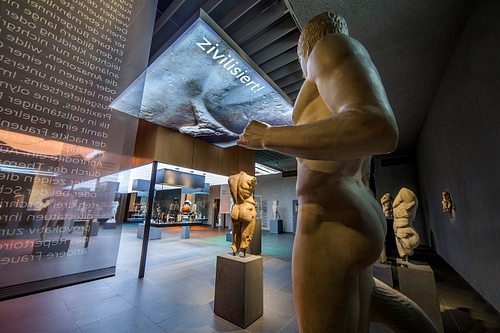
JBW: In the ancient Near East, thousands of stone and terracotta figurines have been excavated and depictions of female nudity predominate. Would you say there is a common denominator amongst these nude female figurines, Dr. Lochman? If so, what is the connection besides the nakedness?
TL: It is evident that all these prehistoric figurines from the Near East (and not only those from the Near East, but also from elsewhere) show the female body not only naked but also in a form that clearly accentuates its sexuality. The breasts, the pelvis, and also the genitals are clearly emphasized, whereas head, arms, and feet are reduced. The common denominator is in my opinion that the figures' aim is to celebrate female sexuality or fertility.
JBW: In what ways did the ancient Egyptians link nudity to social status as well as eroticism in art? It should be mentioned that the ancient Egyptians routinely depicted the gods and children as naked too.
TL: In ancient Egyptian iconography, the social rank of a person was defined by dress; therefore, nudity signified, first and foremost, a "lack of status." And yes, it is true that the ancient Egyptians also depicted children as naked, as they had no status yet as well. In contrast to that particular aspect of nudity in ancient Egyptian art, nudity, of course, played an important role in eroticism and in the appraisal of the beauty and attractiveness of young women. We find naked girls on the handles of toiletries as well in the so-called concubines, which were burial objects added to the grave as substitutes for companions to the grave of deceased men.
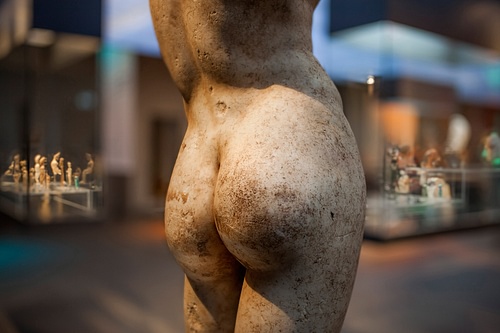
JBW: While touring the exhibition, I was fascinated by the process in which nudity was subsequently normalized within Greek art. Might you comment on this further, Dr. Lochman? Perhaps more than any other Western civilization or culture, we associate the ancient Greeks with the naked body.
TL: Nudity is predominant in ancient Greek art, more than in other cultures, indeed. But more important than the nudity is the fact that the human body in general is the quasi-exclusive topic of Greek arts. Nonetheless, most of the human figures in ancient Greek art do not represent mortal humans, but rather gods and heroes. Some – and this is typical for the Greek anthropocentrism – even represent allegorical figures that personify topographic places, as well as abstract objects and terms.
Therefore, the human body is an important medium for subordinated values or meanings, which provides enough reasoning for depicted bodies to appear better than in nature and even "perfect." A mortal man could only approach the heroic status of gods through training their body in sports. (Of course, they also had to exercise and discipline their mind and spirit too!) Representations of idealized athletes engaged in sport while fully nude are common in Greek art. The ancient Greek representation of ideal men rendered nudity as a kind of "uniform." This is why nudity is such a predominant form of figural representations within ancient Greek art.
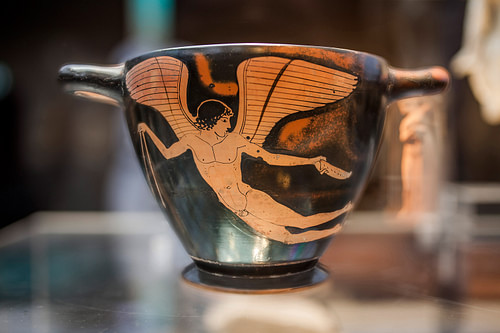
JBW: Dr. Lochman, the Etruscans seemed to differ sharply from that of the Romans who, while frowning upon public nudity, were nonetheless eager to have their private homes filled with nude statues of heroes, deities, and even erotic images. How did the Etruscans view nudity and express it in their own artistic traditions?
TL: One of the significant differences between the Etruscans and the Greeks and Romans is the fact that Etruscan women enjoyed more liberty in social life than Greek and Roman women. Whereas the Greeks sports were reserved to men only, Etruscan girls could practice sport together with the boys and in complete nudity! Public outdoor nudity for both sexes was, therefore, nothing unusual, and it did not have any potential for scandals. This explains why the Etruscans also had a lower reservation against erotic images in the arts.
JBW: The exhibition contains objects made by the ancient Mesopotamians, Egyptians, Syrians, Greeks, Etruscans, and Romans. Among the objects on display, which among them are considered “highlights”? Additionally, do you have any personal favorites among the items from the exhibition?
TL: Even if the exhibition is dominated by Greek works of art, and despite the fact that I am a specialist in Greek and Roman sculpture, two of my favorite highlights are not from Greece or Rome, but from Syria and Egypt. The first one is a Syrian idol – the most ancient item in the exhibit, which dates from around 5000 BCE. It depicts an enthroned opulent beauty in accentuated sexuality, thus celebrating female fertility. The second one is the Egyptian bust of a lady from the court from around 1300 BCE during the New Kingdom (c. 1550 BCE–c. 1077 BCE). She is dressed, but her clothes act as light drapery; the elegant curves and shape of her body appear underneath as if she were naked.
This kind of interplay between revealing and concealing was not only a Greek speciality from the end of 5th century BCE, but it was already mastered by Egyptian artists nine centuries earlier! One highlight from the Greek section should be mentioned here too: The marble torso of the Polykleitian Diadumenos type. Even if this is a later Roman copy, the work is of such delicate fineness that it can be considered as the best of all Roman replicas after the lost masterwork of Polykleitos (fl. 5th century BCE).
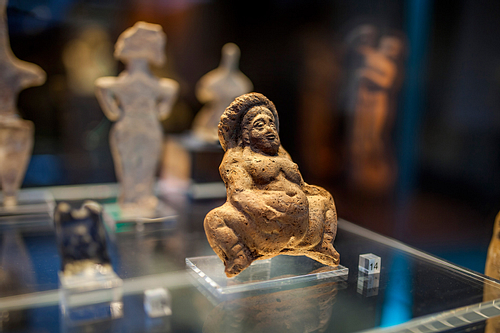
JBW: For artists in ancient times, the depiction of nudity had various associations across space and time; for example, it was tied to immortality, religious sanctity, the pristine state of nature, in addition to notions of civilization. Have we deviated all that much from our ancient ancestors when it comes to nudity in the artistic nude? What are your thoughts, Dr. Lochman?
TL: Nudity is omnipresent not only in ancient arts, but also in modern art where it is generally accepted. The only problem that we may have with nudity in art occurs when represented nudity is not understood or is considered as gratuitous. In the ancient times, nudity always had justification. We can distinguish between ritual nudity, heroic nudity, civilized nudity, uncivilized nudity, legitimized nudity, and erotic nudity.
Strangely, explicit erotic representations, such as those figuring on specific symposium vases, are for many spectators less provocative then naked woman in modern artistic nudes, where the reasons for the nakedness are not concretely discernible (or is not understood anymore).
JBW: Dr. Lochman, on behalf of Ancient History Encyclopedia, I thank you so much for sharing your knowledge with us and for introducing our readers to this compelling exhibition. I wish you many happy adventures in your research until we next meet again.
TL: Many thanks to you and AHE for the interest in our exhibition!
Naked! The Art of Nudity runs at the Antikenmuseum in Basel, Switzerland until April 28, 2019.
Dr. Tomas Lochman was born 1959 in Prague, Czech Republic, and he has lived in Basel, Switzerland since 1969. He studied Classical Archaeology at Basel University from 1980-1986, and he earned his doctorate degree in 1993 with a dissertation on Roman Phyrgia. Since 1986, Dr. Lochman has worked at the Antikenmuseum in Basel, becoming the curator in charge of Greek and Roman Sculpture at the Antikenmuseum in 2013. From 2000-2016, Dr. Lochman was the president of the “International Association for Conservation and Promotion of Casts” (I.A.C.P.C.). In 2006, he received a research grant of the French CNRS as guest at the Institut Français des Etudes Anatoliennes in Istanbul, Turkey. Lochman's research areas include ancient sculpture (from Greece, Rome, and the Eastern Roman Empire) as well as the reception of Antiquity in modern times. In his museum exhibitions and events, Lochman traces deliberately the afterlife of historical heritage in contemporary popular media. Lochman's most important exhibitions are "Antico-mix" (Antiquity in Comics), "Antike im Kino" (Antiquity in Cinema), "The art of Swiss neo-Classical Sculptor Ferdinand Schlöth," "Roma Eterna" (a presentation of sculptures from the Santarelli and Zeri collections), and "Naked! The Art of Nudity."

